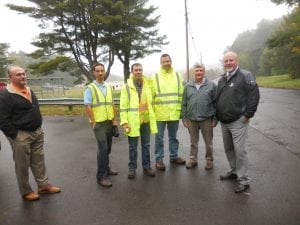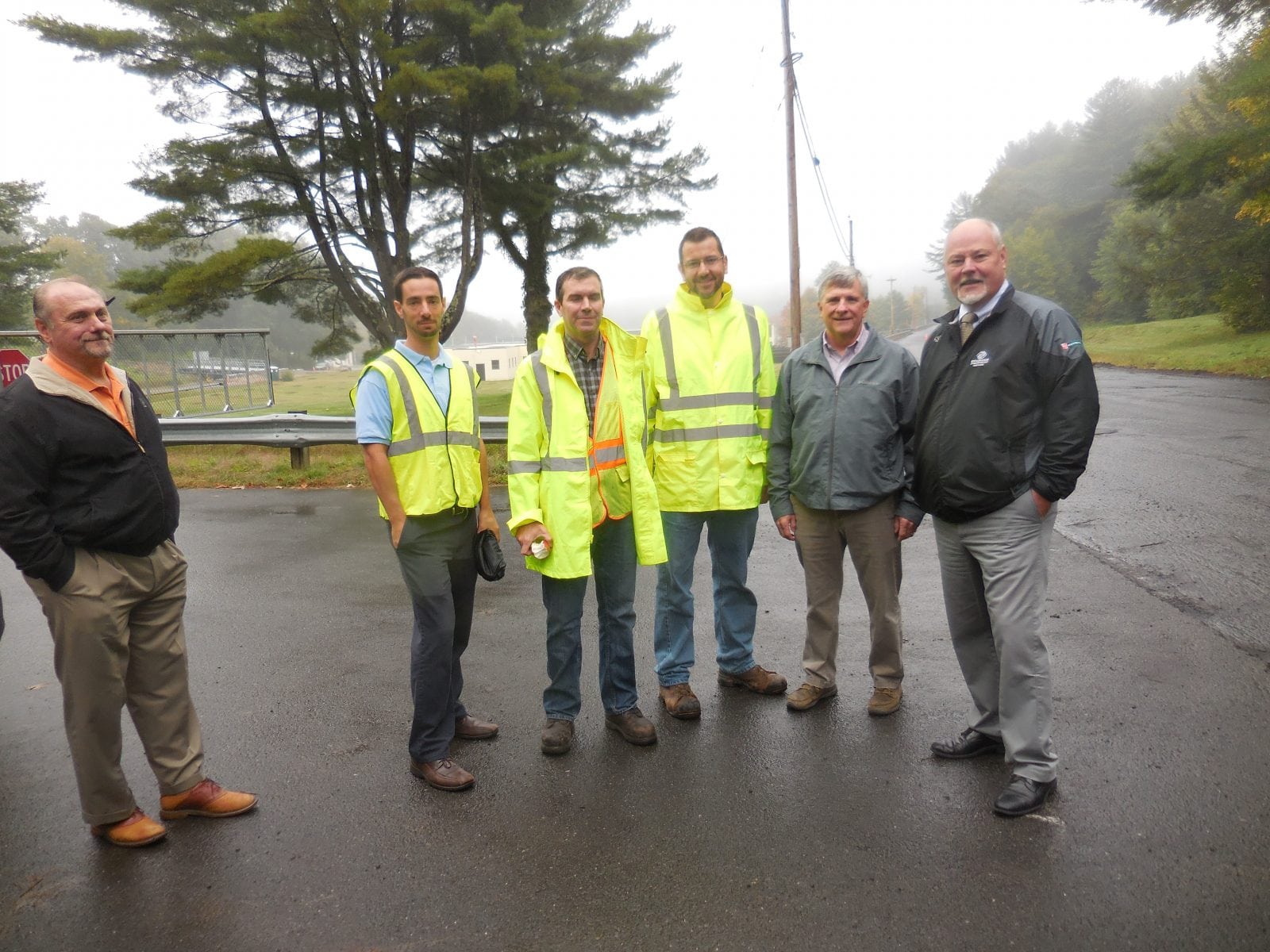
Mark Cressotti, Jeremy Cigal, Engineering; Casey Berube, Highway; Joseph Kietner, Stormwater; Ward 4 Councilor Michael Burns and Mayor Brian P. Sullivan at work site on Granville Road in October. (WNG File Photo)
WESTFIELD – At its meeting on Wednesday, the Legislative & Ordinance Committee took another look at a stormwater fee increase. Department of Public Works Director David Billips said the discussion actually dated back ten years, when the city put together a committee to develop a stormwater fee. Billips said at that time the City Council cut the proposal.
“This proposal is basically what we proposed ten years ago,” Billips said about the original proposal that he gave to the committee last year, and resubmitted on Wednesday along with a new proposal.
He said in the new proposal the stormwater fee for residents, currently at $20, increases to $30 for the next three years. “If you accept this, you’re voting on a one year increase,” he said.
In the original proposal, which Billips said he presented to the City Council eight months ago, the fees for residents increase to $30 in FY2020; $40 in FY21, and $50 in FY22.
Commercial rates in both proposals are also impacted. In the new proposal, the rate would change from the present $.045/sq. ft. of impervious surface to $.014 in FY20 and remain there for three years, with the cap raising from $640 to $1,200 for parcels with impervious surface of 80,000 to 150,000 sq. ft., and to $2,100 for parcels greater than 150,000 sq. ft. Billips said there are about 50 commercial entities in both of these larger categories.
Smaller businesses (less than 45,000 sq. ft.) would pay less each year than they do now, while the larger ones would pay more. Currently, any commercial property 14,222 sq. ft. or greater is paying the maximum cap of $640, Billips said.
In his original proposal, the rate per square footage would be $.014 in FY20, increase to .020 in FY21, and .024 in Fy22. Billips said smaller businesses would still pay less than they do now, while larger entities would pay more.
Billips said the original proposal would meet the need, while the new proposal would create a shortfall of $212,320 in FY21 and $325,340 in FY22. He said his recommendation would be to go with the original proposal. “If you don’t have the votes for it, then vote for (the new one) for one year,” he said, adding that it makes no sense to take a vote for three years when the rates are not going to increase in the second and third year.
“You’re falling behind in stormwater. Without the increase, that’s not going to change,” he said, adding the City Council could accept either plan. He said the estimates in both are conservative, based on the lower ranges for commercial businesses.
Billips also talked about potential grants for stormwater work in the city. “I’ve been doing this a long time. If you show good faith, you’ll get grants.”
Ward 4 Councilor Michael Burns, a member of the L&O committee, asked if they voted on one year of the new proposal, would that be showing good faith. Billips said no.
L&O chairman William Onyski asked what additional work could be done with the revenue from the original proposal. Billips said the DPW could move more aggressively, and bond for the anticipated revenue. He said any increase won’t be realized until the second year.

DPW Stormwater Coordinator Joseph Kietner, Asst. Dir. Francis Cain and Highway Foreman Eric Lacombe discuss stormwater issues at L&O meeting Wednesday. (Photo by Amy Porter)
Eric Keitner, DPW stormwater coordinator, said the more time he spends out in the field, the more problems he finds, citing collapsed pipes and illegal connections, eg. sanitary sewers connected to drainage lines. He said there are many more problems than the DPW can address right now.
Highway division foreman Eric LaCombe said with more revenue, they could implement a different pothole repair, using larger sheets of asphalt. Currently they are using the technique with a rented machine on Granville Rd., Lloyds Hill and Bates Road.
Earlier, Billips praised the work the crew was doing on those roads. “You get the right people, get the right equipment, you can fix these things,” he said, adding that they did the work inhouse at substantial savings.
Burns asked how much stormwater drainage contributed to deteriorating the roads. LaCombe said “a great amount.” He said this is the first time in years he hasn’t seen water come out on the bottom of Holyoke Rd, City View and Granville, where the work has been done.
Onyski said the difference between the two stormwater fee proposals appeared to be $600,000 to $700,000 per year.
At-large Councilor Dan Allie, who did a lot of the work on the original proposal as chair of the Finance sub-committee in 2018, said some of the rates they achieved in the proposal were supplemented by DPW undesignated funds. Billips said $725,000 remained in DPW undesignated funds at present.
Burns stated that he was not in favor of supplementing rate increases with undesignated funds.
At-large Councilor Cindy C. Harris said people would be outraged to increase to $50 in a couple of years. She said the increase should be on the largest companies, such as the Home Depot.
“The Home Depot pays $640 per year right now, the same as a pizza shop. Under the new rate, they would pay $2,100 a year,” Onyski said. Harris said she was in favor of increasing that rate even more.
“I absolutely agree with everything that’s been said must be done. I do not agree with increasing the residents. I’m not saying don’t do it, just do it in a slightly different way,” Harris said.
Onyski asked about removing the cap altogether, or increasing it to $10,000. Billips said it wouldn’t pass. He said the caps are comparable with surrounding communities, but residential rates are way below other communities.
Onyski asked whether they could justify the increase by pointing to the work being done. Billips said a lot of the stormwater work is unseen, but they could quantify some of it.
Ward 1 Councilor Mary Ann Babinski said she hears from a lot of residents about how much they spend on the front end of cars due to potholes, which might help to put it in perspective. She said the first year increase for residents would amount to $2.50 per quarter; the second year, $5 a quarter, and the third, $7.50 a quarter.
“We have to do something,” Billips said.
Onyski said he was going to go with the original proposal, which increases residents to $50 in three years, and would propose increasing the cap for commercial properties to $5,000. Burns made the motion for the recommendation to the City Council, which passed 2-0. The committee’s recommendation will be reported out at the rescheduled City Council meeting on Monday, April 22.


